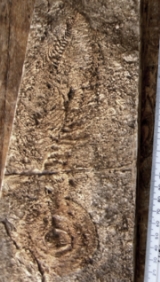
Charniodiscus
Encyclopedia
Charniodiscus is an Ediacaran
fossil
that was probably a stationary filter feeder that lived anchored to a sandy sea bed. The organism had a holdfast
, stalk and frond. The holdfast was bulbous shaped, and the stalk was flexible. The frond was segmented and had a pointed tip. There were two growth forms; one with a short stem and fat frond, and another with a long stalk, elevating a smaller frond about 50 cm above the holdfast. While the organism superficially resembles the sea pen
s (cnidaria
), it is probably not a crown-group animal.
Charniodiscus was first found in the Charnwood Forest
in England, and named by Trevor D. Ford
in 1958. The name is derived from the fact that Ford only described a holdfast consisting of a double concentic circle, his species being named Charniodiscus concentricus. Later it was discovered that a frond (Charnia masoni) was part of a closely related organism. Charnia
differs in the branching structure in the frond.
Charniodiscus specimens are known from across the globe dating to around .
Species are distinguished by the number of segments, whether or not there is a distal spine, and the shape ratio.
Ediacaran
The Ediacaran Period , named after the Ediacara Hills of South Australia, is the last geological period of the Neoproterozoic Era and of the Proterozoic Eon, immediately preceding the Cambrian Period, the first period of the Paleozoic Era and of the Phanerozoic Eon...
fossil
Fossil
Fossils are the preserved remains or traces of animals , plants, and other organisms from the remote past...
that was probably a stationary filter feeder that lived anchored to a sandy sea bed. The organism had a holdfast
Holdfast
A holdfast is a root-like structure that anchors aquatic sessile organisms, such as seaweed, other sessile algae, stalked crinoids, benthic cnidarians, and sponges, to the substrate. ...
, stalk and frond. The holdfast was bulbous shaped, and the stalk was flexible. The frond was segmented and had a pointed tip. There were two growth forms; one with a short stem and fat frond, and another with a long stalk, elevating a smaller frond about 50 cm above the holdfast. While the organism superficially resembles the sea pen
Sea pen
Sea pens are colonial marine cnidarians belonging to the order Pennatulacea. There are 14 families within the order; they are thought to have a cosmopolitan distribution in tropical and temperate waters worldwide...
s (cnidaria
Cnidaria
Cnidaria is a phylum containing over 9,000 species of animals found exclusively in aquatic and mostly marine environments. Their distinguishing feature is cnidocytes, specialized cells that they use mainly for capturing prey. Their bodies consist of mesoglea, a non-living jelly-like substance,...
), it is probably not a crown-group animal.
Charniodiscus was first found in the Charnwood Forest
Charnwood Forest
Charnwood Forest is an upland tract in north-western Leicestershire, England, bounded by Leicester, Loughborough, and Coalville. The area is undulating, rocky and picturesque, with barren areas. It also has some extensive tracts of woodland; its elevation is generally 600 ft and upwards, the area...
in England, and named by Trevor D. Ford
Trevor D. Ford
Trevor D. Ford, OBE is a British geologist, specialising in speleology, and an author. He was a Senior Lecturer in the Geology Department of the University of Leicester, and also Associate Dean of Science....
in 1958. The name is derived from the fact that Ford only described a holdfast consisting of a double concentic circle, his species being named Charniodiscus concentricus. Later it was discovered that a frond (Charnia masoni) was part of a closely related organism. Charnia
Charnia
Charnia is the genus name given to a frond-like Ediacaran lifeform with segmented ridges branching alternately to the right and left from a zig-zag medial suture. The genus Charnia was named after Charnwood Forest in Leicestershire, England, where the first fossilised specimen was found.- Diversity...
differs in the branching structure in the frond.
Charniodiscus specimens are known from across the globe dating to around .
Species are distinguished by the number of segments, whether or not there is a distal spine, and the shape ratio.

